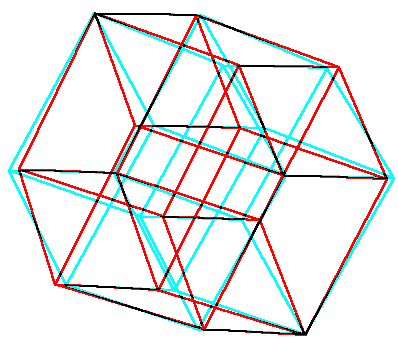#hybercube
Hypercubes
What is a hypercube (also referred to as a tesseract) you say! Well, let’s start with what you know already. We know what a cube is, it’s a box! But how else could you describe a cube? A cube is 3 dimensional. Its 2 dimensional cousin is a square.
A hypercube is just to a cube what a cube is to a square. A hypercube is 4 dimensional! (Actually– to clarify, hypercubes can refer to cubes of all dimensions. “Normal” cubes are 3 dimensional, squares are 2 dimensional “cubes, etc. This is because a hypercube is an n-dimensional figure whose edges are aligned in each of the space’s dimensions, perpendicular to each other and of the same length. A tesseract is specifically a 4-d cube).

[source]
Another way to think about this can be found here:
Start with a point. Make a copy of the point, and move it some distance away. Connect these points. We now have a segment. Make a copy of the segment, and move it away from the first segment in a new (orthogonal) direction. Connect corresponding points. We now have an ordinary square. Make a copy of the square, and move it in a new (orthogonal) direction. Connect corresponding points. We now have a cube. Make a copy and move it in a new (orthogonal, fourth) direction. Connect corresponding points. This is the tesseract.
If a tesseract were to enter our world, we would only see it in our three dimensions, meaning we would see forms of a cube doing funny things and spinning on its axes. This would be referred to as a cross-section of the tesseract. Similarly, if we as 3-dimensional bodies were to enter a 2-dimensional world, its 2-dimension citizens would "observe” us as 2-dimensional cross objects as well! It would only be possible for them to see cross-sections of us.
Why would this be significant? Generally, in math, we work with multiple dimensions very often. While it may seem as though a mathematican must then work with 3 dimensions often, it is not necessarily true. The mathematician deals with these dimensions only mathematically. These dimensions do not have a value because they do not correspond to anything in reality; 3 dimensions are nothing ordinary nor special.
Yet, through modern mathematics and physics, researchers consider the existence of other (spatial) dimensions. What might be an example of such a theory? String theory is a model of the universe which supposes there may be many more than the usual 4 spacetime dimensions (3 for space, 1 for time). Perhaps understanding these dimensions, though seemingly impossible to visualize, will come in hand.
Carl Sagan also explains what a tesseract is.
Image: Peter Forakis, Hyper-Cube, 1967, Walker Art Center, Minneapolis
Post link

